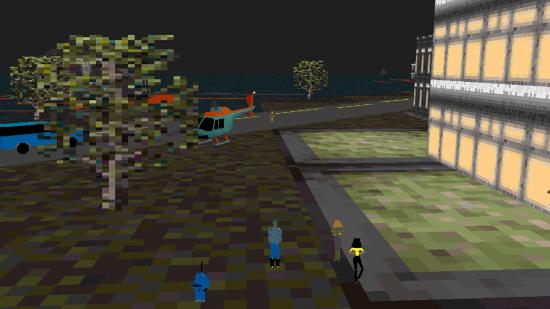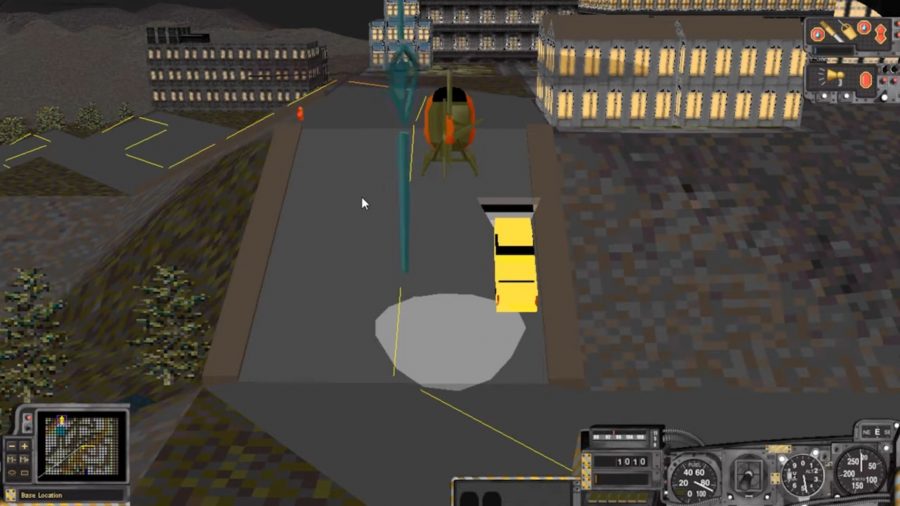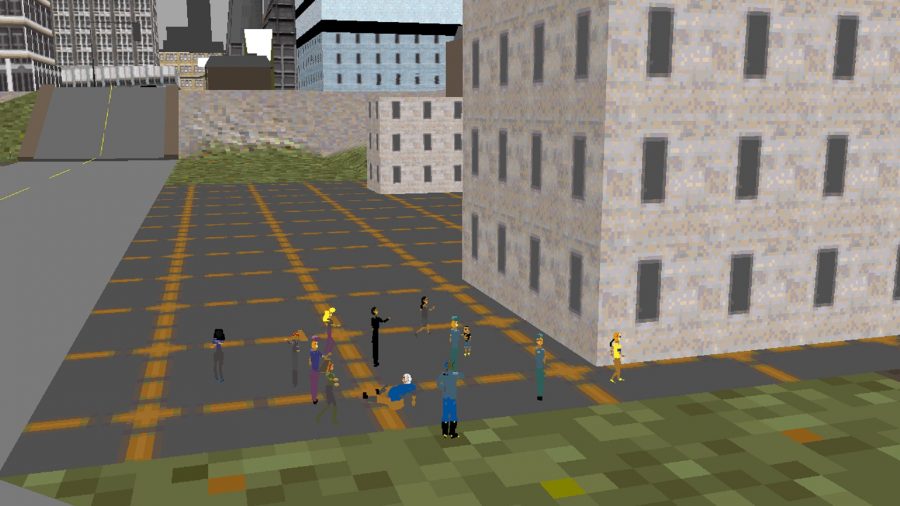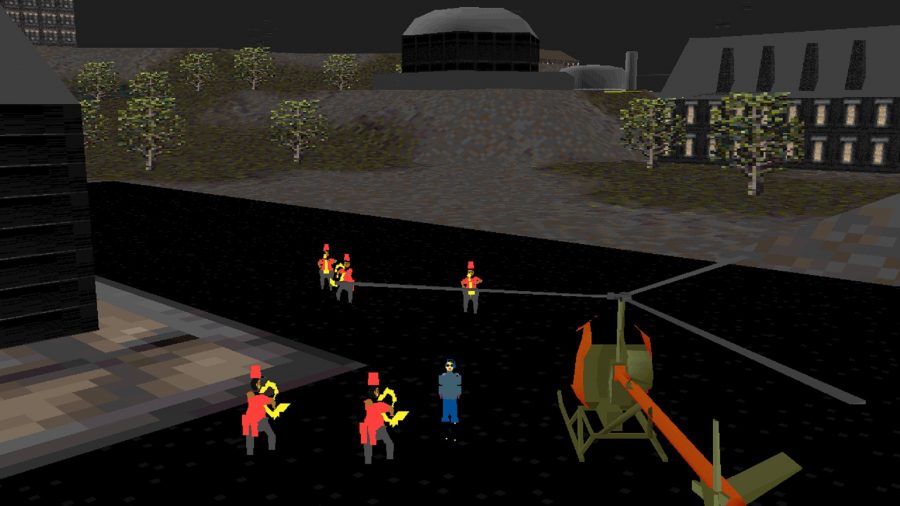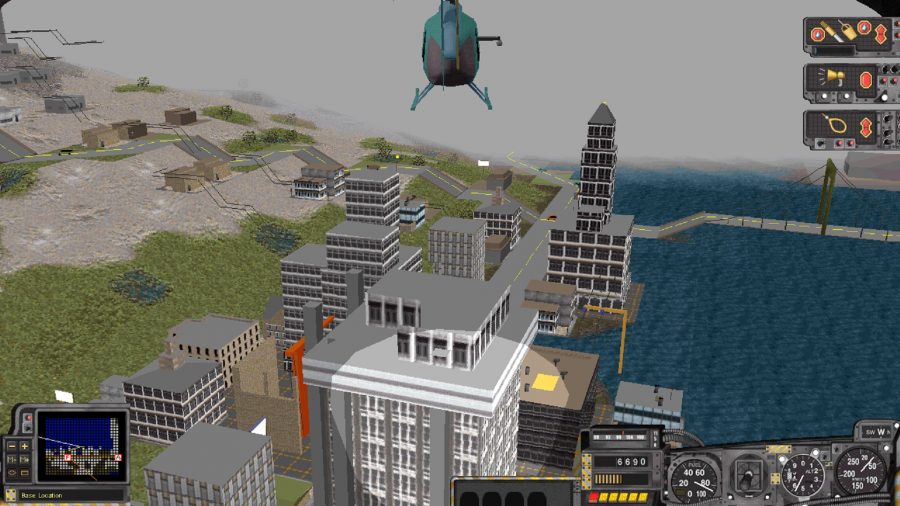SimCity 2000 was one of the most successful games of 1993, but Maxis Software didn’t exactly have a convincing follow-up in mind. Skyscraper simulator SimTower and SimHealth, an unwieldy strategy game about the United States’ healthcare system, shared little except poor sales. With finances looking increasingly dire, management ordered developers to pump out as many titles as possible before the end of 1996. The list includes SimIsle, SimTown, SimGolf, SimTunes, and SimCopter, which features the very first appearance of the Sims.
Released – initially, but we’ll get to that later – just before Christmas 1996, SimCopter was developed by SimCity designer Will Wright, who recalls being asked by management: “can you design a game where you’re doing something in 3D in SimCity? Whatever it is, driving around, flying around, whatever.” Since the designer was already working on a prototype for The Sims at the time, he decided the project should also feature citizens who walk around and interact with each other.
SimCopter puts the player in the cockpit of a police helicopter, tasking them with resolving traffic jams, fires, riots, overturned boats, and chasing down criminals. The flight model was based on a Hindenburg simulator (no, really) that Wright had been forced to shelve because of poor marketability, but it was given a new lease of life with the novel idea of players being able to fly around their own SimCity 2000 maps. Wright had been toying with the idea of merging different simulators ever since SimEarth, with the ultimate goal being “an open standard through which our simulators could be plugged into each other”. In the mid ’90s, the concept of designing a city on an isometric, 2D plane in SimCity and then experiencing it in 3D from a controllable helicopter was revolutionary.
SimCopter is packed with small details: there’s traffic in the streets, boats coast along the rivers, and planes circle above. The city’s inhabitants were brought to life using an early version of Edith, the very same programming language which was being used to develop The Sims.
But there are other connections to Will Wright’s famous series. You can listen to the radio in your chopper, which includes deadpan commercials and announcements, like a PSA recommending against listening to PSAs while flying – exactly the kind of humour that would appear throughout the semi-serious Sims canon. And there are several radio stations to choose from, covering genres like classical, rock, jazz, and techno; it wouldn’t be until GTA III’s release several years later that we’d see a similarly detailed in-game music system.
SimCopter also features the first appearance of the now-iconic Simlish language, which was used to avoid repetitive dialogue ringing out every time you complete a task or help a citizen. While Black Eyed Peas would later go on to record Simlish covers of the group’s biggest hits for The Urbz: Sims in the City, at this early stage it more closely resembled a sequence of screams, bleats, and unintelligible grunts.
Despite some of these ideas being years ahead of their time, SimCopter is a pretty janky experience – you can tell it was the consequence of Maxis’s financial troubles and the team having just six months to develop it. The flight controls are robust, but the emergency call missions and progression systems are lacking any variation. You fly around the city picking up injured Sims and dropping them off at the hospital, or you fly somewhere to shout instructions over your heli’s tannoy, and for your efforts, you earn some points and money which can be used to buy upgrades and new choppers. That’s pretty much it: answer call after call until you’ve got enough money to answer some slightly different calls, or indeed the same calls in a slightly different helicopter. The only alternative is to move to a different city map.
Even for a game that came out in 1996, SimCopter’s 3D graphics look dated. Pausing to take a closer look at a Sims’ design reveals hastily assembled, pixelated monstrosities, and their stilted walking animations only contribute to their horrific appearance. “Had we been given six or eight months more, it would have looked much better,” Wright would comment years later.
And then there are the bugs and glitches. Greeting people with the megaphone may result in Sims suddenly flipping upside down, hurling themselves into the blades of the helicopter, or they might start randomly shooting at you. Police cars, instead of pulling over, often just stop in the middle of the road, causing endless traffic jams – and yep, it’s your job to go and solve those jams. And why are some of the dogs blue?
Still, SimCopter represents a very early glimpse at true sandbox gaming, especially in a 3D space. Crash your helicopter into a car on the street? You’ll need to grab a second bird and head back to the scene to extinguish the fire. Leave your helicopter in the middle of the road? Get ready to solve the subsequent traffic jam. Bad behaviour, like dropping Sims from your helicopter, is punished with point deductions; although it’s comically easy to cheat the system as you earn more points for picking up injured Sims than you lose for injuring them in the first place.
As with so many games from the ’90s, SimCopter also has plenty of cheats, which allow for further experimentation. You can find an attack helicopter and fly around the map firing machine guns and missiles. There are UFO encounters, and if you find one while using the attack helicopter you can shoot it down for more points. You can even cause a nuclear meltdown that destroys half the map. Near and dear to me is a cheat code that turns the pilot into a dog, letting you run around the map at high speeds.
SimCopter also allows a primitive form of modding, since it uses accessible files like WAVs for sounds and videos in Smack format. This lets players easily substitute songs or commercials on the in-game radio stations, and small movies, which are played around the city’s drive-in cinemas. Indeed, SimCopter was one of the most brilliant 3D sandbox games of the time.
While it wouldn’t go on to sell great numbers, SimCopter was by no means a failure – critically at least, it was considered the best of the four Sim games (not to be confused with simulation games) released by Maxis in 1996. The studio would be saved from bankruptcy only by way of an Electronic Arts buyout in 1997, and Will Wright was able to continue working on the home design simulator that would eventually become The Sims.
The release of SimCopter was also hit by one of the most notorious videogame easter eggs of the ’90s. Programmer Jacques Servin inserted a hidden routine in the code that, on certain days of the month, would spawn dozens of male NPCs wearing only swimming trunks, who wander around the city kissing each other. He later described it as an act of rebellion against the allegedly gruelling work conditions in the software house, and a way of countering the sexualisation of the female NPCs in the game, who moan and gyrate if you kiss them. Servin was dismissed, and Maxis had to pause the release of all future copies of SimCopter to patch out the routine, so it missed the 1996 holiday season.
The story of that easter egg, which also involves alleged blackmail, Ace Attorney-like shock reveals, and an artistic hacker group, fits perfectly into the crazed world and development of SimCopter. 25 years later, it remains one of the more obscure Will Wright games, but one that may still give great satisfaction to whoever decides to don a helmet and strap in for a flight around the city.
